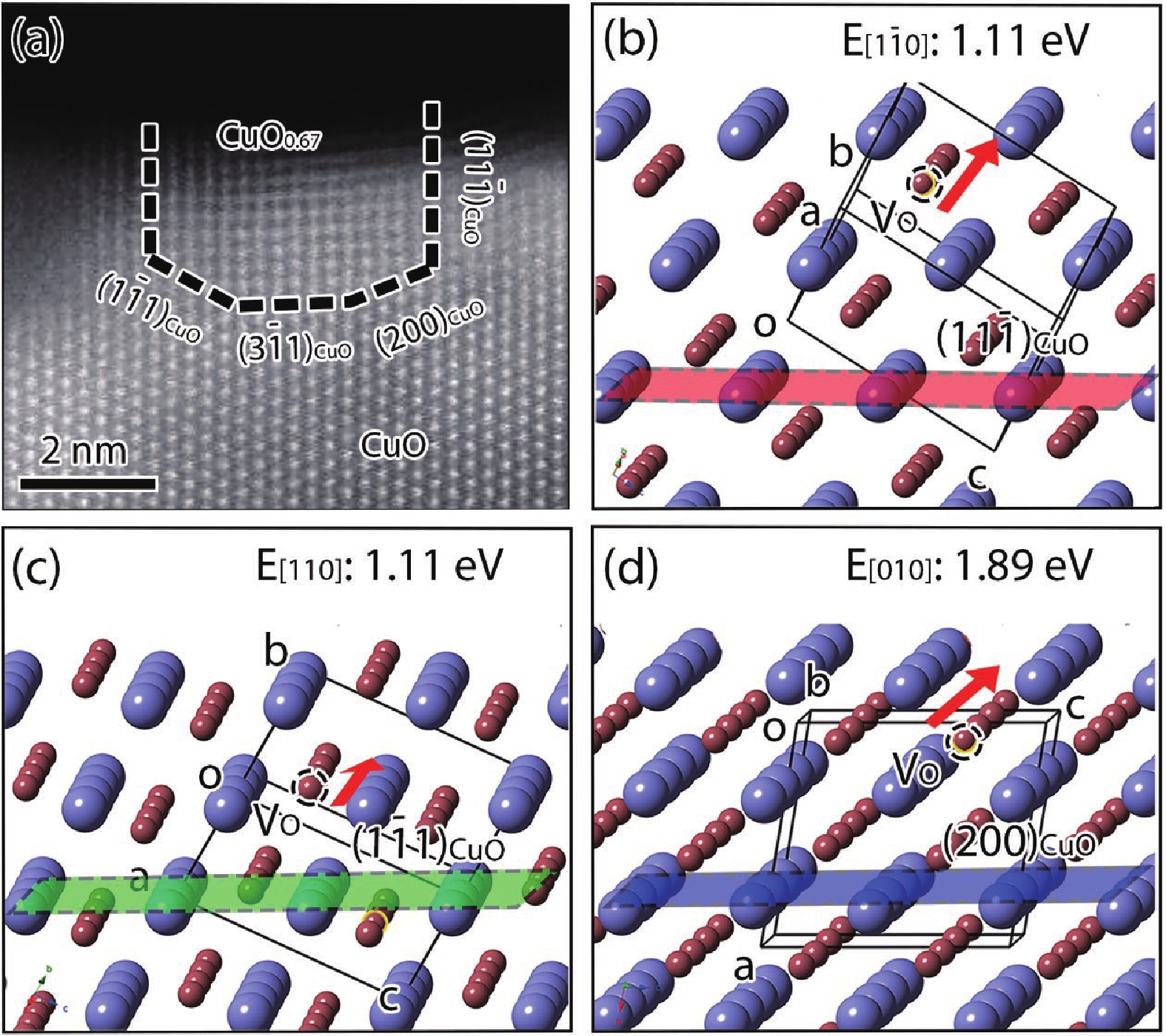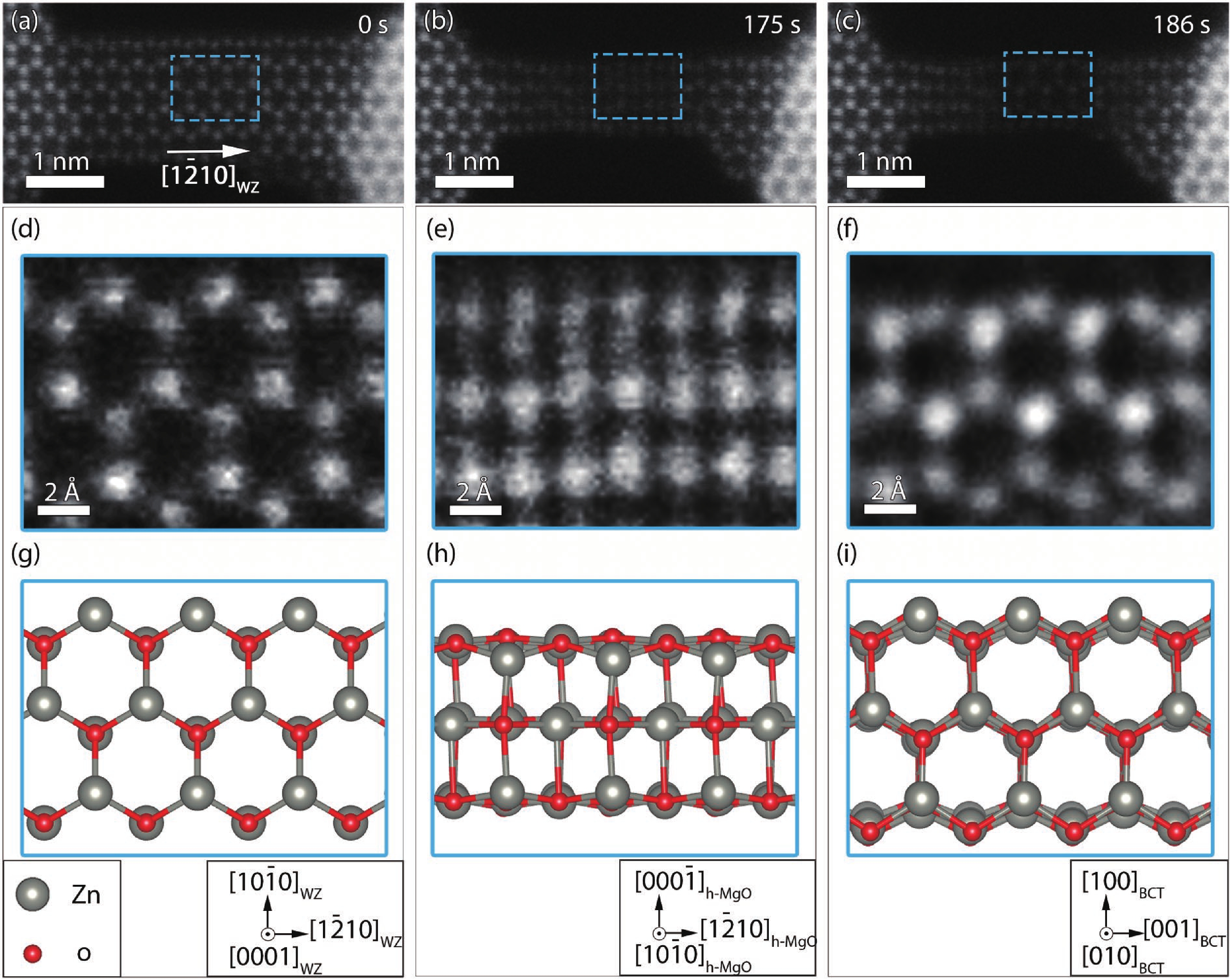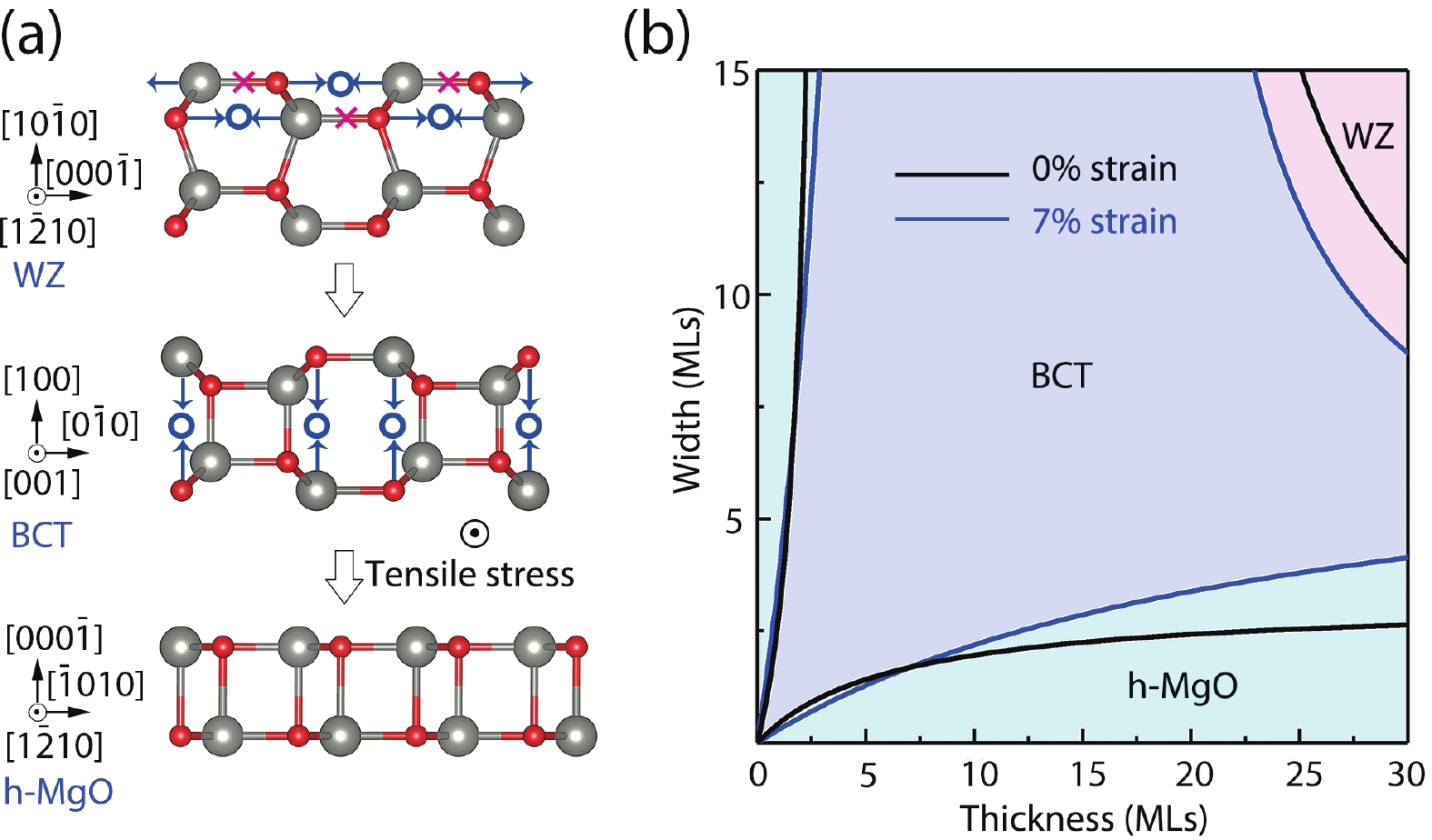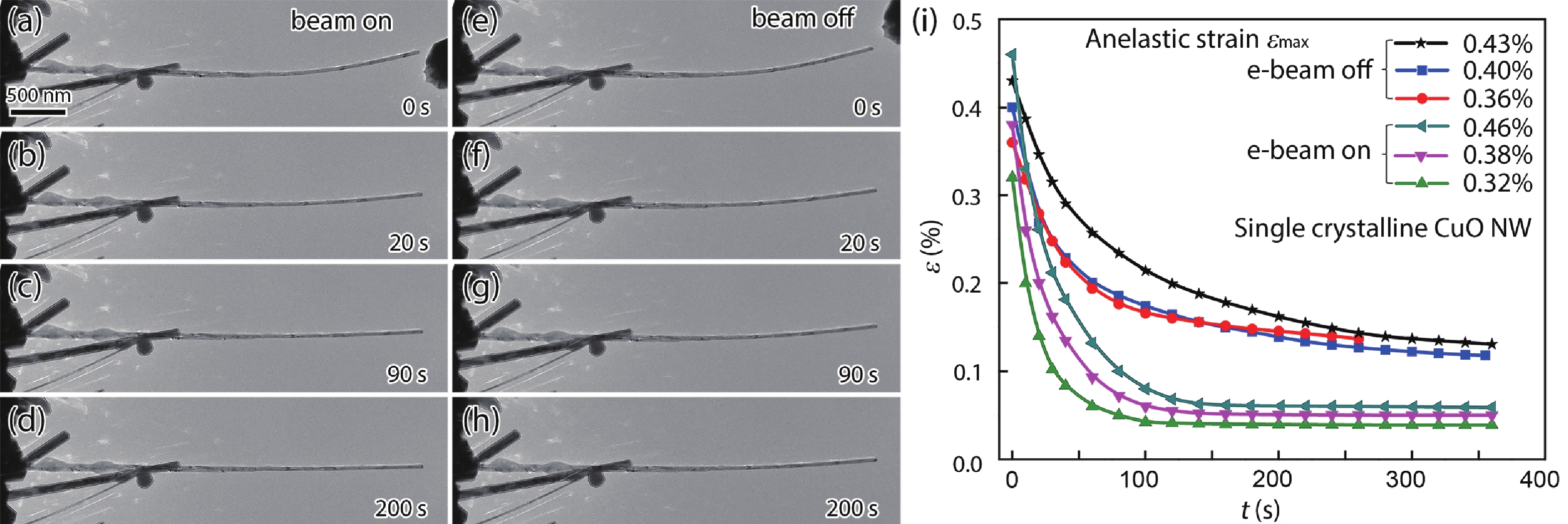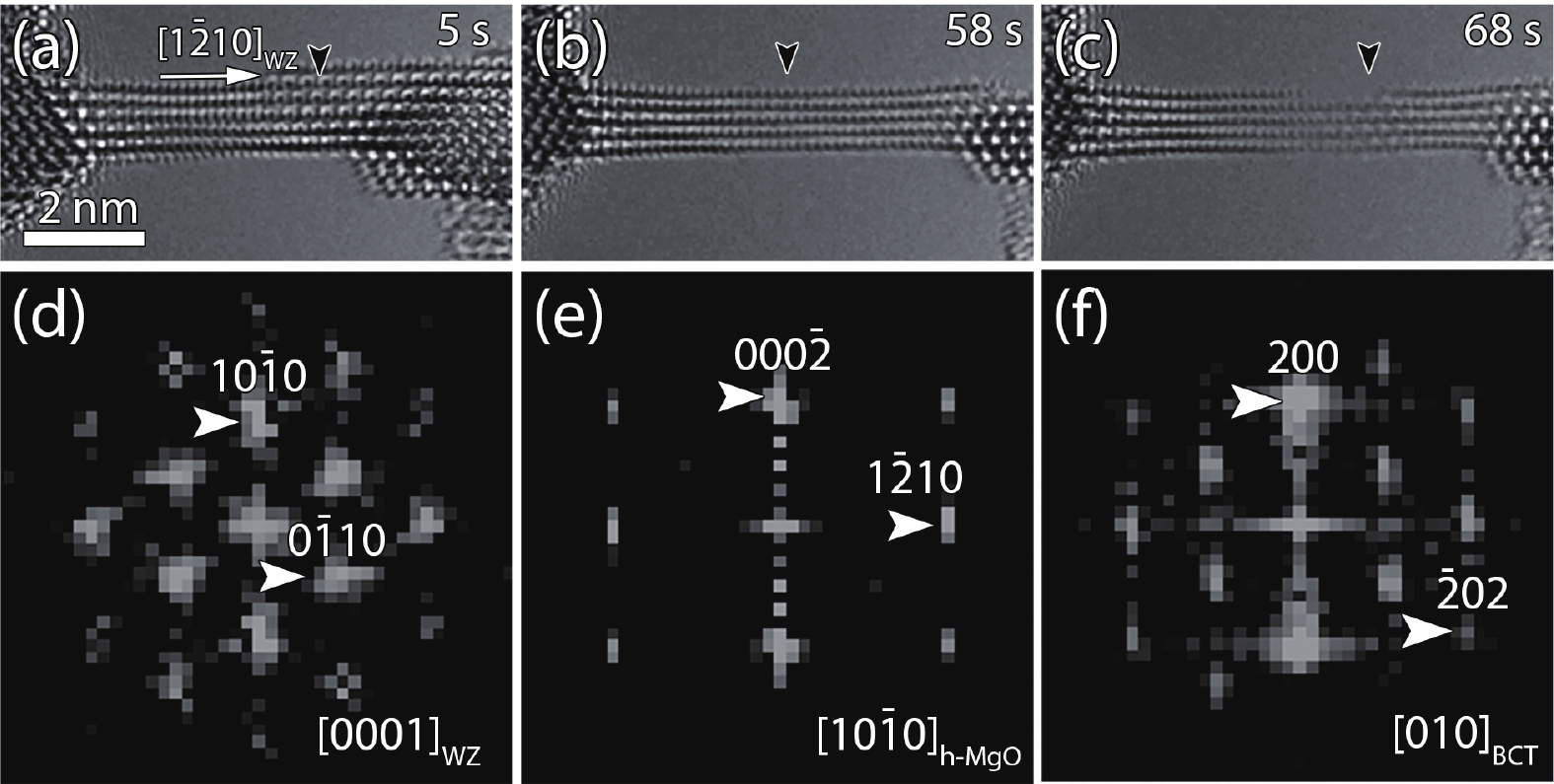| Citation: |
Peili Zhao, Lei Li, Guoxujia Chen, Xiaoxi Guan, Ying Zhang, Weiwei Meng, Ligong Zhao, Kaixuan Li, Renhui Jiang, Shuangfeng Jia, He Zheng, Jianbo Wang. Structural evolution of low-dimensional metal oxide semiconductors under external stress[J]. Journal of Semiconductors, 2022, 43(4): 041105. doi: 10.1088/1674-4926/43/4/041105
****
P L Zhao, L Li, G X J Chen, X X Guan, Y Zhang, W W Meng, L G Zhao, K X Li, R H Jiang, S F Jia, H Zheng, J B Wang. Structural evolution of low-dimensional metal oxide semiconductors under external stress[J]. J. Semicond, 2022, 43(4): 041105. doi: 10.1088/1674-4926/43/4/041105
|
Structural evolution of low-dimensional metal oxide semiconductors under external stress
DOI: 10.1088/1674-4926/43/4/041105
More Information
-
Abstract
Metal oxide semiconductors (MOSs) are attractive candidates as functional parts and connections in nanodevices. Upon spatial dimensionality reduction, the ubiquitous strain encountered in physical reality may result in structural instability and thus degrade the performance of MOS. Hence, the basic insight into the structural evolutions of low-dimensional MOS is a prerequisite for extensive applications, which unfortunately remains largely unexplored. Herein, we review the recent progress regarding the mechanical deformation mechanisms in MOSs, such as CuO and ZnO nanowires (NWs). We report the phase transformation of CuO NWs resulting from oxygen vacancy migration under compressive stress and the tensile strain-induced phase transition in ZnO NWs. Moreover, the influence of electron beam irradiation on interpreting the mechanical behaviors is discussed. -
References
[1] Sheng J Z, Han K L, Hong T H, et al. Review of recent progresses on flexible oxide semiconductor thin film transistors based on atomic layer deposition processes. J Semicond, 2018, 39, 011008 doi: 10.1088/1674-4926/39/1/011008[2] Park J S, Kim H, Kim I D. Overview of electroceramic materials for oxide semiconductor thin film transistors. J Electroceram, 2014, 32, 117 doi: 10.1007/s10832-013-9858-0[3] Dos Santos C L, Piquini P. Diameter dependence of mechanical, electronic, and structural properties of InAs and InP nanowires: a first-principles study. Phys Rev B, 2010, 81, 075408 doi: 10.1103/PhysRevB.81.075408[4] Rim Y S, Chen H J, Zhu B W, et al. Interface engineering of metal oxide semiconductors for biosensing applications. Adv Mater Interfaces, 2017, 4, 1700020 doi: 10.1002/admi.201700020[5] Csiszar G, Lawitzki R, Everett C, et al. Elastic behavior of Nb2O5/Al2O3 core-shell nanowires in terms of short-range-order structures. ACS Appl Mater Interfaces, 2021, 13, 24238 doi: 10.1021/acsami.1c02936[6] Dey A. Semiconductor metal oxide gas sensors: a review. Mat Sci Eng B, 2018, 229, 206 doi: 10.1016/j.mseb.2017.12.036[7] Li S, Zhang M, Wang H. Simulation of gas sensing mechanism of porous metal oxide semiconductor sensor based on finite element analysis. Sci Rep, 2021, 11, 17158 doi: 10.1038/s41598-021-96591-2[8] Ke Y J, Chen J W, Lin G J, et al. Smart windows: electro-, thermo-, mechano-, photochromics, and beyond. Adv Energy Mater, 2019, 9, 1902066 doi: 10.1002/aenm.201902066[9] Alus L, Brontvein O, Kossoy A, et al. Aligned growth of semiconductor nanowires on scratched amorphous substrates. Adv Funct Mater, 2021, 31, 2103950 doi: 10.1002/adfm.202103950[10] Chen H D, Zhang Z, Huang B J, et al. Progress in complementary metal-oxide-semiconductor silicon photonics and optoelectronic integrated circuits. J Semicond, 2015, 36, 121001 doi: 10.1088/1674-4926/36/12/121001[11] Troughton J, Atkinson D. Amorphous InGaZnO and metal oxide semiconductor devices: an overview and current status. J Mater Chem C, 2019, 7, 12388 doi: 10.1039/C9TC03933C[12] Perrotta A, Pilz J, Milella A, et al. Opto-chemical control through thermal treatment of plasma enhanced atomic layer deposited ZnO: an in situ study. Appl Surf Sci, 2019, 483, 10 doi: 10.1016/j.apsusc.2019.03.122[13] Hofmann A I, Cloutet E, Hadziioannou G. Materials for transparent electrodes: from metal oxides to organic alternatives. Adv Electron Mater, 2018, 4, 1700412 doi: 10.1002/aelm.201700412[14] Yu X, Marks T J, Facchetti A. Metal oxides for optoelectronic applications. Nat Mater, 2016, 15, 383 doi: 10.1038/nmat4599[15] Wang L H, Kong D L, Xin T J, et al. Deformation mechanisms of bent Si nanowires governed by the sign and magnitude of strain. Appl Phys Lett, 2016, 108, 151903 doi: 10.1063/1.4946855[16] Minamisawa R A, Suess M J, Spolenak R, et al. Top-down fabricated silicon nanowires under tensile elastic strain up to 4.5%. Nat Commun, 2012, 3, 1096 doi: 10.1038/ncomms2102[17] Zhang C, Kvashnin D G, Bourgeois L, et al. Mechanical, electrical, and crystallographic property dynamics of bent and strained Ge/Si core-shell nanowires as revealed by in situ transmission electron microscopy. Nano Lett, 2018, 18, 7238 doi: 10.1021/acs.nanolett.8b03398[18] Han X, Kou L, Lang X, et al. Electronic and mechanical coupling in bent ZnO nanowires. Adv Mater, 2009, 21, 4937 doi: 10.1002/adma.200900956[19] Li J, Shan Z W, Ma E. Elastic strain engineering for unprecedented materials properties. MRS Bull, 2014, 39, 108 doi: 10.1557/mrs.2014.3[20] Jia L, Shu D J, Wang M. Tuning the area percentage of reactive surface of TiO2 by strain engineering. Phys Rev Lett, 2012, 109, 156104 doi: 10.1103/PhysRevLett.109.156104[21] Thulin L, Guerra J. Calculations of strain-modified anatase TiO2 band structures. Phys Rev B, 2008, 77, 195112 doi: 10.1103/PhysRevB.77.195112[22] Lim B, Cui X Y, Ringer S P. Strain-mediated bandgap engineering of straight and bent semiconductor nanowires. Phys Chem Chem Phys, 2021, 23, 5407 doi: 10.1039/D1CP00457C[23] Bao P T, Wang Y B, Cui X Y, et al. Atomic-scale observation of parallel development of super elasticity and reversible plasticity in GaAs nanowires. Appl Phys Lett, 2014, 104, 021904 doi: 10.1063/1.4861846[24] Chen B, Gao Q, Wang Y B, et al. Anelastic behavior in GaAs semiconductor nanowires. Nano Lett, 2013, 13, 3169 doi: 10.1021/nl401175t[25] Han X D, Zhang Y F, Zheng K, et al. Low-temperature in situ large strain plasticity of ceramic SiC nanowires and its atomic-scale mechanism. Nano Lett, 2007, 7, 452 doi: 10.1021/nl0627689[26] Wei B, Zheng K, Ji Y, et al. Size-dependent bandgap modulation of ZnO nanowires by tensile strain. Nano Lett, 2012, 12, 4595 doi: 10.1021/nl301897q[27] Sheng H P, Zheng H, Cao F, et al. Anelasticity of twinned CuO nanowires. Nano Res, 2015, 8, 3687 doi: 10.1007/s12274-015-0868-x[28] Varghese B, Zhang Y, Feng Y P, et al. Probing the size-structure-property correlation of individual nanowires. Phys Rev B, 2009, 79, 115419 doi: 10.1103/PhysRevB.79.115419[29] Liu K H, Wang W L, Xu Z, et al. In situ probing mechanical properties of individual tungsten oxide nanowires directly grown on tungsten tips inside transmission electron microscope. Appl Phys Lett, 2006, 89, 221908 doi: 10.1063/1.2397547[30] Agrawal R, Paci J T, Espinosa H D. Large-scale density functional theory investigation of failure modes in ZnO nanowires. Nano Lett, 2010, 10, 3432 doi: 10.1021/nl1014926[31] Wang L H, Zhang Z, Han X D. In situ experimental mechanics of nanomaterials at the atomic scale. npg Asia Mater, 2013, 5, e40 doi: 10.1038/am.2012.70[32] Zheng H, Cao F, Zhao L, et al. Atomistic and dynamic structural characterizations in low-dimensional materials: recent applications of in situ transmission electron microscopy. Microscopy, 2019, 68, 423 doi: 10.1093/jmicro/dfz038[33] Sheng H, Zheng H, Jia S, et al. Atomistic manipulation of reversible oxidation and reduction in Ag with an electron beam. Nanoscale, 2019, 11, 10756 doi: 10.1039/C8NR09525F[34] Liu H H, Zheng H, Li L, et al. Surface-coating-mediated electrochemical performance in CuO nanowires during the sodiation-desodiation cycling. Adv Mater Interfaces, 2018, 5, 1701255 doi: 10.1002/admi.201701255[35] Jia S, Hu S, Zheng H, et al. Atomistic interface dynamics in Sn-catalyzed growth of wurtzite and zinc-blende ZnO nanowires. Nano Lett, 2018, 18, 4095 doi: 10.1021/acs.nanolett.8b00420[36] Zheng H, Wang J, Huang J Y, et al. Void-assisted plasticity in Ag nanowires with a single twin structure. Nanoscale, 2014, 6, 9574 doi: 10.1039/C3NR04731H[37] Zheng H, Wang J, Huang J Y, et al. In situ visualization of birth and annihilation of grain boundaries in an Au nanocrystal. Phys Rev Lett, 2012, 109, 225501 doi: 10.1103/PhysRevLett.109.225501[38] Zhang J, Li Y, Li X, et al. Timely and atomic-resolved high-temperature mechanical investigation of ductile fracture and atomistic mechanisms of tungsten. Nat Commun, 2021, 12, 2218 doi: 10.1038/s41467-021-22447-y[39] Chen S, Oh H S, Gludovatz B, et al. Real-time observations of TRIP-induced ultrahigh strain hardening in a dual-phase CrMnFeCoNi high-entropy alloy. Nat Commun, 2020, 11, 826 doi: 10.1038/s41467-020-14641-1[40] Liu B Y, Liu F, Yang N, et al. Large plasticity in magnesium mediated by pyramidal dislocations. Science, 2019, 365, 73 doi: 10.1126/science.aaw2843[41] Wang S, Shan Z, Huang H. The mechanical properties of nanowires. Adv Sci, 2017, 4, 1600332 doi: 10.1002/advs.201600332[42] Huang J Y, Zheng H, Mao S X, et al. In situ nanomechanics of GaN nanowires. Nano Lett, 2011, 11, 1618 doi: 10.1021/nl200002x[43] Huang L L, Zheng F Y, Deng Q M, et al. In situ scanning transmission electron microscopy observations of fracture at the atomic scale. Phys Rev Lett, 2020, 125, 246102 doi: 10.1103/PhysRevLett.125.246102[44] Agrawal R, Peng B, Espinosa H D. Experimental-computational investigation of ZnO nanowires strength and fracture. Nano Lett, 2009, 9, 4177 doi: 10.1021/nl9023885[45] Wang Q, Wang J, Li J, et al. Consecutive crystallographic reorientations and superplasticity in body-centered cubic niobium nanowires. Sci Adv, 2018, 4, eaas8850 doi: 10.1126/sciadv.aas8850[46] Wang L H, Liu P, Guan P, et al. In situ atomic-scale observation of continuous and reversible lattice deformation beyond the elastic limit. Nat Commun, 2013, 4, 2413 doi: 10.1038/ncomms3413[47] Stinville J C, Charpagne M A, Bourdin F, et al. Measurement of elastic and rotation fields during irreversible deformation using Heaviside-digital image correlation. Mater Charact, 2020, 169, 110600 doi: 10.1016/j.matchar.2020.110600[48] Agrawal R, Peng B, Gdoutos E E, et al. Elasticity size effects in ZnO nanowires – a combined experimental-computational approach. Nano Lett, 2008, 8, 3668 doi: 10.1021/nl801724b[49] Wang G, and Li X. Size dependency of the elastic modulus of ZnO nanowires: Surface stress effect. Appl Phys Lett, 2007, 91, 242 doi: 10.1063/1.2821118[50] Wang J, Kulkarni A J, Ke F J, et al. Novel mechanical behavior of ZnO nanorods. Comput Methods Appl Mech Eng, 2008, 197, 3182 doi: 10.1016/j.cma.2007.10.011[51] Cao F, Li L, Zheng H, et al. Controllable elasticity storage and release in CuO-Pt core-shell nanowires. ChemNanoMat, 2018, 4, 1140 doi: 10.1002/cnma.201800368[52] Egbo K O, Liu C P, Ekuma C E, et al. Vacancy defects induced changes in the electronic and optical properties of NiO studied by spectroscopic ellipsometry and first-principles calculations. J Appl Phys, 2020, 128, 135705 doi: 10.1063/5.0021650[53] Zhang J, Shi J, Qi D C, et al. Recent progress on the electronic structure, defect, and doping properties of Ga2O3. APL Mater, 2020, 8, 020906 doi: 10.1063/1.5142999[54] Lu Z, Huang B, Li G, et al. Shear induced deformation twinning evolution in thermoelectric InSb. npj Comput Mater, 2021, 7, 111 doi: 10.1038/s41524-021-00581-x[55] Wei S, Wang Q, Wei H, et al. Bending-induced deformation twinning in body-centered cubic tungsten nanowires. Mater Res Lett, 2019, 7, 210 doi: 10.1080/21663831.2019.1578833[56] Wang J, Zeng Z, Wen M, et al. Anti-twinning in nanoscale tungsten. Sci Adv, 2020, 6, eaay2792 doi: 10.1126/sciadv.aay2792[57] Chen Y, Burgess T, An X, et al. Effect of a high density of stacking faults on the Young's modulus of GaAs nanowires. Nano Lett, 2016, 16, 1911 doi: 10.1021/acs.nanolett.5b05095[58] Mignerot F, Kedjar B, Bahsoun H, et al. Size-induced twinning in InSb semiconductor during room temperature deformation. Sci Rep, 2021, 11, 19441 doi: 10.1038/s41598-021-98492-w[59] Dai S, Zhao J, He M R, et al. Elastic properties of GaN nanowires: revealing the influence of planar defects on Young's modulus at nanoscale. Nano Lett, 2015, 15, 8 doi: 10.1021/nl501986d[60] Cao F, Jia S F, Zheng H, et al. Thermal-induced formation of domain structures in CuO nanomaterials. Phys Rev Mater, 2017, 1, 053401 doi: 10.1103/PhysRevMaterials.1.053401[61] Wang L, Zheng K, Zhang Z, et al. Direct atomic-scale imaging about the mechanisms of ultralarge bent straining in Si nanowires. Nano Lett, 2011, 11, 2382 doi: 10.1021/nl200735p[62] Dhanaraj G, Dudley M, Bliss D, et al. Growth and process induced dislocations in zinc oxide crystals. J Cryst Growth, 2006, 297, 74 doi: 10.1016/j.jcrysgro.2006.09.025[63] Wang X, Chen K, Zhang Y, et al. Growth conditions control the elastic and electrical properties of ZnO nanowires. Nano Lett, 2015, 15, 7886 doi: 10.1021/acs.nanolett.5b02852[64] Choudhary K, Liang T, Chernatynskiy A, et al. Charge optimized many-body (COMB) potential for Al2O3 materials, interfaces, and nanostructures. J Phys: Condens Matter, 2015, 27, 305004 doi: 10.1088/0953-8984/27/30/305004[65] Gorski W S. Theorie der elastischen nachwirkung in ungeordneten mischkristallen zweiter. Phys Z Sowj, 1935, 8, 457[66] Schaumann G, Völki J, Alefeld G. The diffusion coefficients of hydrogen and deuterium in vanadium, niobium, and tantalum by gorsky-effect measurements. Phys Status Solidi B, 1970, 42, 401 doi: 10.1002/pssb.19700420141[67] Schaumann G, Völkl J, Alefeld G. Relaxation process due to long-range diffusion of hydrogen and deuterium in niobium. Phys Rev Lett, 1968, 21, 891 doi: 10.1103/PhysRevLett.21.891[68] Cheng G M, Miao C Y, Qin Q Q, et al. Large anelasticity and associated energy dissipation in single-crystalline nanowires. Nat Nanotech, 2015, 10, 687 doi: 10.1038/nnano.2015.135[69] Li L, Chen G, Zheng H, et al. Room-temperature oxygen vacancy migration induced reversible phase transformation during the anelastic deformation in CuO. Nat Commun, 2021, 12, 3863 doi: 10.1038/s41467-021-24155-z[70] Sun X, Zhu W, Wu D, et al. Surface-reaction induced structural oscillations in the subsurface. Nat Commun, 2020, 11, 305 doi: 10.1038/s41467-019-14167-1[71] Wang Z L. ZnO nanowire and nanobelt platform for nanotechnology. Mater Sci Eng R, 2009, 64, 33 doi: 10.1016/j.mser.2009.02.001[72] Freeman C L, Claeyssens F, Allan N L, et al. Graphitic nanofilms as precursors to wurtzite films: theory. Phys Rev Lett, 2006, 96, 066102 doi: 10.1103/PhysRevLett.96.066102[73] Morgan B J. First-principles study of epitaxial strain as a method of B4→BCT stabilization in ZnO, ZnS, and CdS. Phys Rev B, 2010, 82, 153408 doi: 10.1103/PhysRevB.82.153408[74] Jeannin M, Artioli A, Rueda-Fonseca P, et al. Light-hole exciton in a nanowire quantum dot. Phys Rev B, 2017, 95, 035305 doi: 10.1103/PhysRevB.95.035305[75] Sponza L, Goniakowski J, Noguera C. Confinement effects in ultrathin ZnO polymorph films: electronic and optical properties. Phys Rev B, 2016, 93, 195435 doi: 10.1103/PhysRevB.93.195435[76] Yamamoto S, Mishina T. Observation of dark exciton luminescence from ZnO nanocrystals in the quantum confinement regime. Phys Rev B, 2011, 83, 165435 doi: 10.1103/PhysRevB.83.165435[77] Zhao X, Wei C M, Yang L, et al. Quantum confinement and electronic properties of silicon nanowires. Phys Rev Lett, 2004, 92, 236805 doi: 10.1103/PhysRevLett.92.236805[78] Liu B H, Mcbriarty M E, Bedzyk M J, et al. Structural transformations of zinc oxide layers on Pt(111). J Phys Chem C, 2014, 118, 28725 doi: 10.1021/jp510069q[79] Deng X Y, Yao K, Sun K J, et al. Growth of single- and bilayer ZnO on Au(111) and interaction with copper. J Phys Chem C, 2013, 246, 11211 doi: 10.1021/jp402008w[80] Weirum G, Barcaro G, Fortunelli A, et al. Growth and surface structure of zinc oxide layers on a Pd(111) surface. J Phys Chem C, 2010, 114, 15432 doi: 10.1021/jp104620n[81] Zhao P L, Guan X X, Zheng H, et al. Surface- and strain-mediated reversible phase transformation in quantum-confined ZnO nanowires. Phys Rev Lett, 2019, 123, 216101 doi: 10.1103/PhysRevLett.123.216101[82] Kulkarni A J, Zhou M, Sarasamak K, et al. Novel phase transformation in ZnO nanowires under tensile loading. Phys Rev Lett, 2006, 97, 105502 doi: 10.1103/PhysRevLett.97.105502[83] Wang J, Kulkarni A J, Sarasamak K, et al. Molecular dynamics and density functional studies of a body-centered-tetragonal polymorph of ZnO. Phys Rev B, 2007, 76, 172103 doi: 10.1103/PhysRevB.76.172103[84] Jiang N. Electron beam damage in oxides: a review. Rep Prog Phys, 2016, 79, 016501 doi: 10.1088/0034-4885/79/1/016501[85] Egerton R F, Li P, Malac M. Radiation damage in the TEM and SEM. Micron, 2004, 35, 399 doi: 10.1016/j.micron.2004.02.003[86] Susi T, Meyer J C, Kotakoski J. Quantifying transmission electron microscopy irradiation effects using two-dimensional materials. Nat Rev Phys, 2019, 1, 397 doi: 10.1038/s42254-019-0058-y[87] Lee S B. Rocksalt ZnO nanocrystal formation by beam irradiation of wurtzite ZnO in a transmission electron microscope. Physica E, 2016, 84, 310 doi: 10.1016/j.physe.2016.07.001[88] Zhao L L, Li L, Sheng H P, et al. Atomistic insight into ordered defect superstructures at novel grain boundaries in CuO nanosheets: From structures to electronic properties. Nano Res, 2019, 12, 1099 doi: 10.1007/s12274-019-2354-3[89] Jia S F, Li L, Zhao L L, et al. Surface-dependent formation of Zn clusters in ZnO single crystals by electron irradiation. Phys Rev Mater, 2018, 2, 060402 doi: 10.1103/PhysRevMaterials.2.060402[90] Look D C, Hemsky J W, Sizelove J R. Residual native shallow donor in ZnO. Phys Rev Lett, 1999, 82, 2552 doi: 10.1103/PhysRevLett.82.2552[91] Coskun C, Look D C, Farlow G C, et al. Radiation hardness of ZnO at low temperatures. Semicond Sci Technol, 2004, 19, 752 doi: 10.1088/0268-1242/19/6/016[92] Kucheyev S O, Jagadish C, Williams J S, et al. Implant isolation of ZnO. J Appl Phys, 2003, 93, 2972 doi: 10.1063/1.1542939[93] Ooe K, Seki T, Ikuhara Y, et al. High contrast STEM imaging for light elements by an annular segmented detector. Ultramicroscopy, 2019, 202, 148 doi: 10.1016/j.ultramic.2019.04.011[94] Ishikawa R, Findlay S D, Seki T, et al. Direct electric field imaging of graphene defects. Nat Commun, 2018, 9, 3878 doi: 10.1038/s41467-018-06387-8[95] Shibata N, Findlay S D, Kohno Y, et al. Differential phase-contrast microscopy at atomic resolution. Nat Phys, 2012, 8, 611 doi: 10.1038/nphys2337[96] Lee T, Mas'ud F A, Kim M J, et al. Spatially resolved Raman spectroscopy of defects, strains, and strain fluctuations in domain structures of monolayer graphene. Sci Rep, 2017, 7, 16681 doi: 10.1038/s41598-017-16969-z[97] Huang M, Yan H, Heinz T F, et al. Probing strain-induced electronic structure change in graphene by Raman spectroscopy. Nano Lett, 2010, 10, 4074 doi: 10.1021/nl102123c[98] Dennett C A, Hua Z, Khanolkar A, et al. The influence of lattice defects, recombination, and clustering on thermal transport in single crystal thorium dioxide. APL Mater, 2020, 8, 111103 doi: 10.1063/5.0025384 -
Proportional views





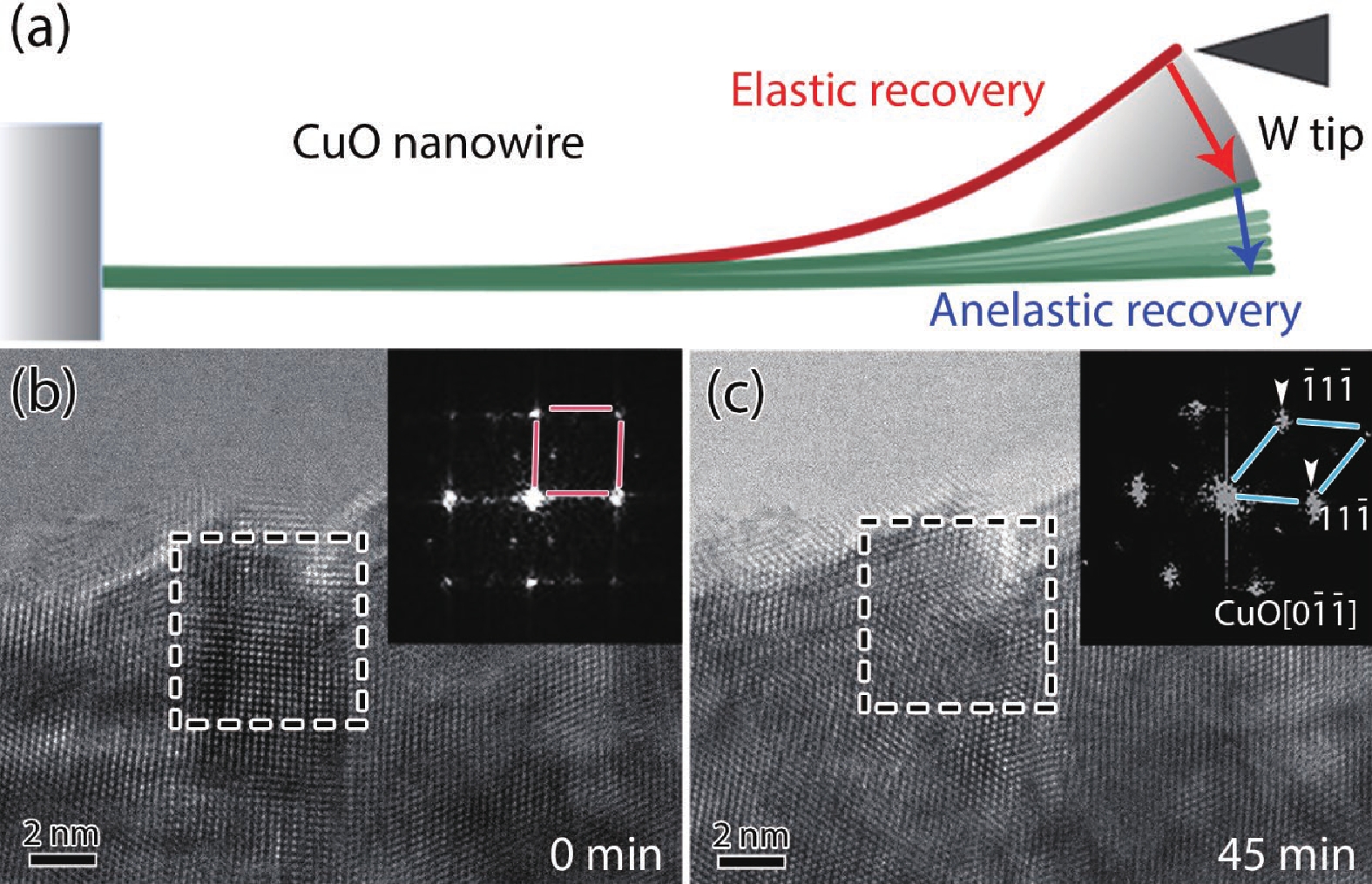
 DownLoad:
DownLoad:
